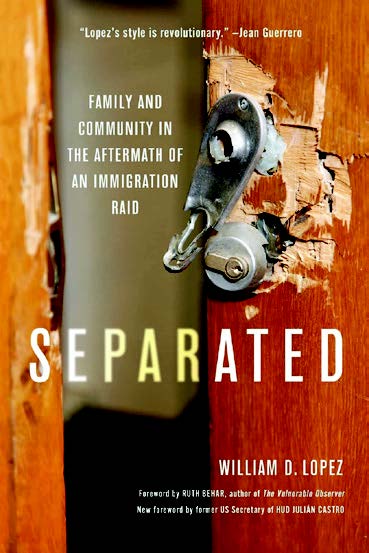Separated: Family and Community in the Aftermath of an Immigration Raid

Many authors, journalists, and academics have written
and exposed the flawed U.S. immigration system
and the impacts it has beyond the individual. This
book examines the lives of surrounding individuals
that have been deported back to Mexico and the repercussions this
has on those left behind in the United States. One interesting take
from this book is that the book is not situated in the southern U.S.
border, but in the Midwest, in Washtenaw County, Michigan. This
is especially impactful because this shows that immigration is not
something simply focused on California, Arizona, and Texas, but
that Latino population is present throughout the entire U.S. Other
compelling aspects of this book are that it does not just focus on the
telling of individual stories of individuals impacted by deportation, but
it takes both a public health and systemic approach of understanding
the underlying causes for why the immigration system in the U.S. is
flawed. These perspectives add value to the knowledge some of us
possess on the U.S. immigration system and on the lives of Latinos
who have been historically impacted by the racialization of such laws.
The book is organized by providing a general overview of the main
protagonist of the immigration raid the book is centered on, it is
followed by a discussion of before the raid, accounts of the raid itself,
and the impact on families and communities after the raid. The prose
is developed for broad readership, which is beneficial for academic
and non-academic audiences who want to know more about the lives
of mixed-status Latino families in Michigan. While I appreciate that
this book is aimed at a wide audience, the book would have benefited
from a bit more discussion with the academic literature to connect
the dots better for non-academics. This would have created a greater
impact for the book because non-academics could see the repercussion
of government policies on the life of Latino mixed-status families and
communities, as well as gotten a stronger understanding of how good
health is more than just eating healthy and exercising, but that it is tied
to various social determinants of health, such as the political context
of the geographical location an individual and community resides.
As briefly touched upon, many scholars have discussed the impact of
immigration on mixed-status Latino families, but what this book does
differently and builds on is that it engages on various sub-themes, such
as gender, individual and community levels of impact, and draws in
the public health perspective. This book also uses ethnographic and
qualitative interviews to tell a compelling story of the lives of these
Latinos. Many articles and manuscripts in public health discuss these
issues, but this book really discusses the impacts of witnessing a
raid firsthand and the negative effect on physical and mental health.
These negative health impacts are relayed by parents, adults, and
children who witness the raid. One of the mothers whose husband
was deported discusses the trance of her daughter after the raid.
How the child was wandering aimlessly and how months later the
child suffers from various physical health issues. In addition, Lopez
also discusses the health impacts of the men who were detained in
immigration facilities. Many of these men suffered drastic weight loss
from the type of food they were fed and from their lack of appetite
due to the constant worry they had concerning their inability to
provide for their families. Similar thoughts were described by the
mothers who entered single motherhood instantly after their male
partners were removed from the United States. They had fears, pain,
and stress that contributed to their poor physical and mental health.
These accounts were vividly recounted and impactful for the reader.
Another aspect Lopez beautifully describes is the various layers of
impact immigration raids have on Latino families. For instance, the
book addresses both the individual and community level impacts.
Here the author goes beyond incorporating the individuals affected by
the raid and includes members of community organizations to paint
a picture of how immigration policies and enforcement do not only
change the lives of families, but of communities. He discusses how
these women whose partners were deported marcadas (marked) or
stigmatized by community members. He also discusses the impact
of one raid on the whole community. How it increased fears of law
enforcement, immigration enforcement, fears to go out to work,
take children to school, and look for basic needs, such as food and
water. Other important interactions described are the interactions
between these women and law enforcement and their landlord.
These interactions are particularly important because it shows
how gendered immigration is and how the many of the individuals
who are deported and arrested are primarily men in comparison
to women. It also signals how the landlord exploited his tenants
once the raid occurred. The landlord did this by taking value items
as payment and removing these women from the premises.
Something else the author does well is examine the parallels
between Black and Latino men as it pertains to law enforcement,
not just ICE. Lopez discusses how Black men are impacted by
police brutality and suffer losing their lives in some situations and
compares this to the cooperation between local and immigration
law enforcement in the practice of detaining immigrant Latino
men. Included among these valuable insights is that Lopez
goes beyond interviewing the victims of the immigration
raid but also interviews local law enforcement to enhance his
understanding between the cooperation of these two agencies.
Overall, this book eloquently brings to light many aspects that are
often ignored or not known about the impacts and aftermath of
immigration raids on Latino families. It shows that mixed-status
families are vulnerable and do not have access to the necessary
to help sustain their U.S. citizen children and family members.
